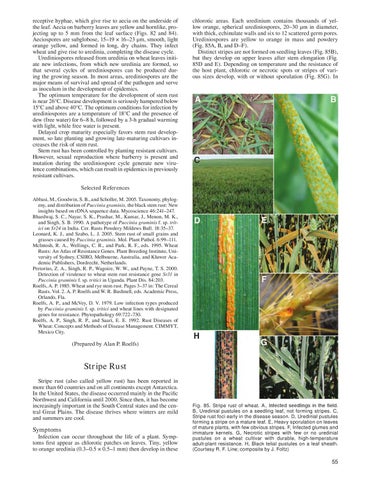receptive hyphae, which give rise to aecia on the underside of the leaf. Aecia on barberry leaves are yellow and hornlike, pro jecting up to 5 mm from the leaf surface (Figs. 82 and 84). Aeciospores are subglobose, 15–19 × 16–23 µm, smooth, light orange yellow, and formed in long, dry chains. They infect wheat and give rise to uredinia, completing the disease cycle. Urediniospores released from uredinia on wheat leaves initi ate new infections, from which new uredinia are formed, so that several cycles of urediniospores can be produced dur ing the growing season. In most areas, urediniospores are the major means of survival and spread of the pathogen and serve as inoculum in the development of epidemics. The optimum temperature for the development of stem rust is near 26°C. Disease development is seriously hampered below 15°C and above 40°C. The optimum conditions for infection by urediniospores are a temperature of 18°C and the presence of dew (free water) for 6–8 h, followed by a 3-h gradual warming with light, while free water is present. Delayed crop maturity especially favors stem rust develop ment, so late planting and growing late-maturing cultivars in creases the risk of stem rust. Stem rust has been controlled by planting resistant cultivars. However, sexual reproduction where barberry is present and mutation during the urediniospore cycle generate new viru lence combinations, which can result in epidemics in previously resistant cultivars.
chlorotic areas. Each uredinium contains thousands of yel low orange, spherical urediniospores, 20–30 µm in diameter, with thick, echinulate walls and six to 12 scattered germ pores. Urediniospores are yellow to orange in mass and powdery (Fig. 85A, B, and D–F). Distinct stripes are not formed on seedling leaves (Fig. 85B), but they develop on upper leaves after stem elongation (Fig. 85D and E). Depending on temperature and the resistance of the host plant, chlorotic or necrotic spots or stripes of vari ous sizes develop, with or without sporulation (Fig. 85G). In
Selected References Abbasi, M., Goodwin, S. B., and Scholler, M. 2005. Taxonomy, phylog eny, and distribution of Puccinia graminis, the black stem rust: New insights based on rDNA sequence data. Mycoscience 46:241–247. Bhardwaj, S. C., Nayar, S. K., Prashar, M., Kumar, J., Menon, M. K., and Singh, S. B. 1990. A pathotype of Puccinia graminis f. sp. trit ici on Sr24 in India. Cer. Rusts Powdery Mildews Bull. 18:35–37. Leonard, K. J., and Szabo, L. J. 2005. Stem rust of small grains and grasses caused by Puccinia graminis. Mol. Plant Pathol. 6:99–111. McIntosh, R. A., Wellings, C. R., and Park, R. F., eds. 1995. Wheat Rusts: An Atlas of Resistance Genes. Plant Breeding Institute, Uni versity of Sydney, CSIRO, Melbourne, Australia, and Kluwer Aca demic Publishers, Dordrecht, Netherlands. Pretorius, Z. A., Singh, R. P., Wagoire, W. W., and Payne, T. S. 2000. Detection of virulence to wheat stem rust resistance gene Sr31 in Puccinia graminis f. sp. tritici in Uganda. Plant Dis. 84:203. Roelfs, A. P. 1985. Wheat and rye stem rust. Pages 3–37 in: The Cereal Rusts. Vol. 2. A. P. Roelfs and W. R. Bushnell, eds. Academic Press, Orlando, Fla. Roelfs, A. P., and McVey, D. V. 1979. Low infection types produced by Puccinia graminis f. sp. tritici and wheat lines with designated genes for resistance. Phytopathology 69:722–730. Roelfs, A. P., Singh, R. P., and Saari, E. E. 1992. Rust Diseases of Wheat: Concepts and Methods of Disease Management. CIMMYT, Mexico City.
(Prepared by Alan P. Roelfs)
Stripe Rust Stripe rust (also called yellow rust) has been reported in more than 60 countries and on all continents except Antarctica. In the United States, the disease occurred mainly in the Pacific Northwest and California until 2000. Since then, it has become increasingly important in the South Central states and the cen tral Great Plains. The disease thrives where winters are mild and summers are cool.
Symptoms Infection can occur throughout the life of a plant. Symp toms first appear as chlorotic patches on leaves. Tiny, yellow to orange uredinia (0.3–0.5 × 0.5–1 mm) then develop in these
Fig. 85. Stripe rust of wheat. A, Infected seedlings in the field. B, Uredinial pustules on a seedling leaf, not forming stripes. C, Stripe rust foci early in the disease season. D, Uredinial pustules forming a stripe on a mature leaf. E, Heavy sporulation on leaves of mature plants, with few obvious stripes. F, Infected glumes and immature kernels. G, Necrotic stripes with few or no uredinial pustules on a wheat cultivar with durable, high-temperature adult-plant resistance. H, Black telial pustules on a leaf sheath. (Courtesy R. F. Line; composite by J. Foltz)
55
